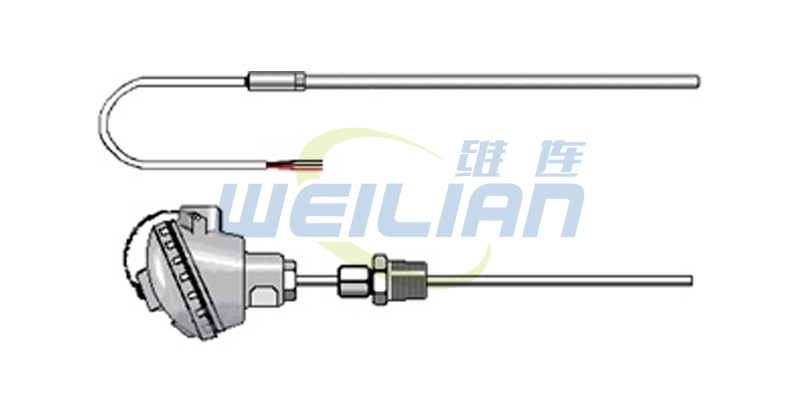 What is the difference between RTD temperature sensor and PT100?
What is the difference between RTD temperature sensor and PT100?What is the difference between thermal resistance thermometer and PT100 thermometer?
PT100 is a version of RTD (resistor temperature detector), and there is no difference between the two.
What is RTD?
The resistor -type temperature detector, also known as RTD or resistance thermometer, is a temperature sensor. RTD includes sensing elements, connecting sensor elements to the wire of the measuring instrument, and supporting the support of sensor elements in the process.
PT100 sensor is the most common resistance thermometer type. These sensors are very popular in the process of laboratory and industrial production in many industries. The main reason to use them is their stability and accuracy. They are superior measuring instruments and provide duplicate confidence. Make sure that each temperature reading will get the same result. > RTD is divided into industrial use and general use. Each type has PT100, PT250, PT500 and PT1000. ("PT" is a symbol of platinum, and "100" is the resistance of ohm at 0 ° C). The resistance between the two points between the conductor is defined. When a volt constant potential difference between the two points is applied to the current in the conductor, the conductor is not a seat of any voltage. These are called linear resistors.
The design of RTD to ensure accurate and repeated temperature and resistance characteristics. The type of material for the RTD structure will determine the temperature limit that RTD can reach. The sensor in RTD is a resistor that changes the resistance value with the temperature. The resistance occurs with a predictable rate with changes in temperature, and can provide the temperature of the processing material by measuring.
The sensor element in the resistance temperature sensor usually contains a coil or a substrate with a platinum film. The allowable resistance to the extension line connected to the sending element is measured at the distance from the measured process or material. A protective cover (usually stainless steel) is equipped with sensor elements. Platinum is a typical material choice in a thermal resistance, because it allows a larger temperature range, it is a more stable material. If you need a lower temperature range, nickel and copper can also be used for RTD structure. Table I. Overview the available temperature range of each material.
Table 1: Sensing component material and RTD temperature limit |
| Materials |
Use temperature range |
| Platinum |
200 ℃ -850 ℃ |
| Nickel |
100 ℃ -315 ℃ |
| Copper |
75 ℃ -150 ℃ |
The wire insulation type used in the resistance thermometer also affects the resistance temperature. Table 2A. Refers to the most commonly used wires and insulation materials and its temperature limit. Table 2B. Refers to the wires to control the instrument or the temperature limit of the connection component to the control instrument or the temperature limit. The typical choice of wire insulation includes nickel, nickel alloy, tin -plated copper, silver -plated copper or nickel -plated copper.
| Table 2A: Connectal temperature limit-structure |
| wire/insulation material |
Maximum use temperature |
| Nickel -plated copper/TFE polytetrafluoroethylene insulation |
250 degrees Celsius |
| Solid -state nickel silk |
650OC |
| Solid copper line |
300oc |
| Table 2B: Connection The temperature limit-extension |
| wire/insulation material |
Maximum use temperature |
| Tin -plated copper/polyvinyl chloride insulation |
105 degrees Celsius |
| Silver -plated copper/polyfricon fluoride insulation |
205 degrees Celsius |
| Silver -plated copper/TFE polytetrafluoroethylene insulation |
250 degrees Celsius |
| Nickel -plated copper/TFE polytetrafluoroethylene insulation |
250 degrees Celsius |
| Nickel -plated copper/glass fiber insulation material |
480 degrees Celsius |
There are two most commonly used methods for RTD temperature sensor structure. The most common is to place RTD components and connect wires to a closed metal tube. The tube is equipped with vibration reduction and/or heat transfer materials. In most cases, alumina powder is used, and the opening of the mouth of silicon resin, epoxy resin or ceramic cement is used.
Another construction method is to use the mineral insulation metal sheath (MIMS) cable. RTD components insert a drilling hole and connect to the nickel or copper wires that are connected to the magnesium oxide (MGO) insulation. The end is also closed with magnesium oxide insulation and welding. The other end is sealed before the extension line connection.
Once the temperature range and application are determined, Wilian will choose the most suitable material and method to build the thermal resistance temperature sensor.
2, 3 or 4 line configuration
The dual -line structure is the least accurate. 2 Line RTDS is often used with short -drawing, or in places that do not need accuracy.
The three -line structure is the most popular choice, industrial applications, and the four -line structure is used in the laboratory, and the close accuracy is essential.
When choosing the correct RTD temperature sensor for your needs, there are many options to consider:
1. The rated temperature
2. Tolerance, accuracy and interchangeability
3. Time response
4. The distance from the control or measurement device
RTD is suitable for a wide range of industrial fields, including air adjustment and refrigeration, stoves and grilled racks, textile production, food processing, plastic, petrochemical and air, gas and liquid temperature measurement. When using the resistor temperature timing, the accuracy and stability you need, the accuracy must be extended to a wide temperature range.

 What is the difference between RTD temperature sensor and PT100?
What is the difference between RTD temperature sensor and PT100?


